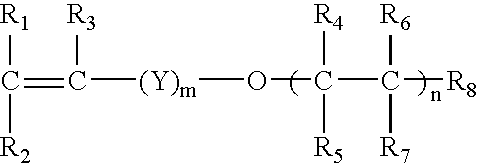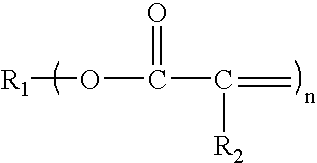Coated substrate with properties of keratinous tissue
a technology of keratinous tissue and coated substrate, which is applied in the field of manufacture of articles, can solve the problems of raising reliability concerns, expensive and time-consuming tests, and subjective human feedback
- Summary
- Abstract
- Description
- Claims
- Application Information
AI Technical Summary
Benefits of technology
Problems solved by technology
Method used
Image
Examples
example 1
[0094] The following example illustrates one process of creating a mold and imparting to the substrate a texture that has been modeled directly from the skin.
[0095] Make a first negative imprint of keratinous tissue by applying a material1 capable of forming a cast, or mold, onto a body part, for example, human skin and / or hair. Remove the cast and allow to dry for 3-7 min. Make a positive mold that resembles the body part in both form and texture by placing for example silicone or other suitable material2 in the negative mold. Impress the positive mold into polyurethane or other suitable material to create a second negative mold, and allow the second negative mold to cure overnight. Optionally, press the positive molds into a unitary mold of polyurethane or other suitable material to create multiple negative molds. Optionally, coat the second negative mold with a 1:1 mixture of Skin-Flex SC-893 stretch paint (aliphatic polyurethane gloss paint) and Skin-Flex SC-89 thinner4 to crea...
example 2
[0096] The following illustrates one example of the process for making a suitable substrate:
[0097] Combine equal amounts of Part A and Part B of TC-410 polyurethane, or equivalent materials, and thoroughly mix. Slowly pour a sufficient amount of the mixture into a desired mold, starting from the edge and gradually moving to the center of the mold. The amount should be sufficient to produce a substrate having a thickness of approximately 0.1 mm-1 cm. One example of a suitable amount is 25 ml in a mold having an area of 7 cm×14 cm. Allow to cure overnight. Begin peeling the polymer substrate from the mold, starting from the edge. Cut away the border if necessary. When poured into a mold as described in Example 1, the substrate thus made has the texture of human keratinous tissue of the body part used to make the first negative imprint.
example 3
[0098] The following example illustrates a process of directly imparting a texture to a substrate surface.
[0099] A patterned surface resembling the surface of mammalian keratinous tissue, for example forearm skin, or hair, may be mechanically etched onto a metallic surface, following standard procedures of photolithography known to one of skill in the art. First, create a pattern that resembles the texture of human skin, for example, from the forearm, either as a computer-simulated image, or as an actual image (e.g. photographic, microscopic) from the human body part of interest. Transfer the pattern to a clear sheet to form a mask. Place the mask onto a copper, brass or other appropriate metallic sheet, upon which a photoresist has been previously adhered or laminated. A variety of photoresists are available commercially, for example DuPont™ MX series dry film photoresists. The selection of the photoresist is based on the desired size, texture and / or feature of the keratinous tiss...
PUM
| Property | Measurement | Unit |
|---|---|---|
| total surface energy | aaaaa | aaaaa |
| total surface energy | aaaaa | aaaaa |
| thickness | aaaaa | aaaaa |
Abstract
Description
Claims
Application Information
 Login to View More
Login to View More - R&D
- Intellectual Property
- Life Sciences
- Materials
- Tech Scout
- Unparalleled Data Quality
- Higher Quality Content
- 60% Fewer Hallucinations
Browse by: Latest US Patents, China's latest patents, Technical Efficacy Thesaurus, Application Domain, Technology Topic, Popular Technical Reports.
© 2025 PatSnap. All rights reserved.Legal|Privacy policy|Modern Slavery Act Transparency Statement|Sitemap|About US| Contact US: help@patsnap.com


